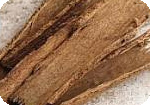| Tuesday, 13 May 2025 Home • About Us • Contact Us |
|
|
|
You are here:
Cinnamon has many unique healing properties, and this revitalizing spice is both a useful addition to the kitchen and provides natural relief for a variety of ailments.
Cinnamon is the brown bark of the cinnamon tree, an Asian evergreen tree. The bark is peeled off, dried, and allowed to form a roll - the common "cinnamon stick" that we know today. There are actually four types of cinnamon. Cinnamomum zeylanicum, more commonly known as "Ceylon", is considered true cinnamon. The others are relatives of this variety, and are known as Chinese cassia or Indonesian cinnamon. They all come from the same tree and are similar in taste, but Ceylon has a slightly richer and sweeter taste. Most of the cinnamon commonly consumed is the less expensive cassia variety. Cinnamon is a source of manganese, iron, calcium, and fiber and contains cinnamaldehyde, cinnamyl acetate, and cinnamyl alcohol, substances that work as antioxidants in the body. In fact, cinnamon's unique healing abilities come mainly from these three components in the essential oils found in its bark, as well as from some other volatile substances. Health Benefits Traditionally, cinnamon is valued for its warming and cleansing qualities. It has been used to provide relief from the onset of a cold or flu, especially when mixed in a tea with some fresh ginger. Gargling with equal amounts of honey and cinnamon mixed in hot water has been used to battle bad breath, and many people chew on a stick of fresh cinnamon daily for overall health preservation. Brain and Mood Cinnamon has a surprisingly strong effect on the brain and mood. Studies have found that its distinct smell works directly on the brain to increase alertness, and has been found to help students concentrate more effectively in exams. Through a different process, cinnamon is associated with helping to prevent mood swings caused by fluctuating blood-sugar levels. Researchers from China evaluated 122 Chinese herbs for their effectiveness at reducing uric acid, the trigger for gout and arthritis flare-ups. Cinnamon cassia extract proved the most effective of them all for inhibiting the enzyme responsible for producing uric acid. In an animal study, male rats that were given an extract of cinnamon had lower blood glucose levels. A human study found that giving cinnamon extract to type 2 diabetes significantly reduced their blood sugar levels. In one study, rats were given a sugar solution to increase their blood pressure. Then they were given ground cinnamon extract, or a placebo. The rats that were given the ground cinnamon and cinnamon extract had reduced blood pressure. Tips on Using Cinnamon
References
Link to this article: Show: HTML Link • Full Link • Short Link
Related Articles:
You must be registered and logged in to comment. |
|
 |
 | |
|
|








